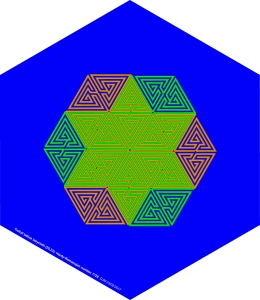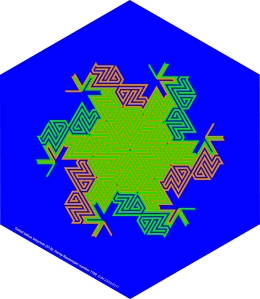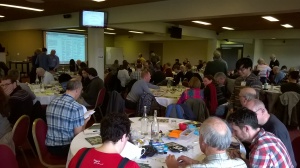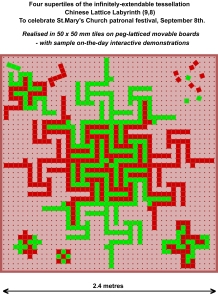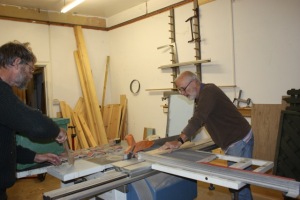Mention Pythagoras and Pythagorean triangles spring to mind, but his theorem is really about the area of certain squares (regular polygons with four sides) and sums of their areas, which happens to relate to the sides of the aforesaid triangles. The forgotten Trithagoras discovered a beautifully analogous theorem which really is about the area of triangles, certain equilateral triangles (regular polygons with three sides), and the sums of their areas.
It’s fun to derive both theorems using complex numbers displayed on the Argand diagram. If you have not clicked off at the mention of complex and Argand, hello again. Firstly, here are the presentation slides as a Powerpoint, Trithagoras.Rev.
Possibly easier to understand than slides without words there follows a rather long-winded explanation; far more conscientious than could be included in the presentation at the MathsJam 2017 conference at the likeable conference centre Yarnfield Park, where the five minutes maximum duration was humorously but rigorously enforced. But first let’s look at a perhaps unfamiliar way of generating PYTHAGOREAN triples -the three integral sides of right-angled triangles.
But first let’s look at a perhaps unfamiliar way of generating PYTHAGOREAN triples -the three integral sides of right-angled triangles.
The complex number 8 + 3i, for instance, can be represented as a point with coordinates (8,3) on the Argand diagram. It also represents a vector connecting this point with the origin with length (the modulus of the complex number) √(8² + 3²). You can see from the diagram below how this can specify the figure of a square of area (8² + 3²).
Note that, in general, complex numbers (a,b) where a and b are integral are known as Gaussian integers (see the diagram below).
 The next figure below illustrates the procedure for multiplying two complex numbers, in this case (3,2) and (4,1), to get their product, (10,11) and how that is equivalent to multiplying together two square figures, of areas (3² + 2²) and (4² + 1²) to produce a product square of area (10² + 11²), which equals (3² + 2²) x (4² + 1²). I bet you will not resist checking that this multiplication works.
The next figure below illustrates the procedure for multiplying two complex numbers, in this case (3,2) and (4,1), to get their product, (10,11) and how that is equivalent to multiplying together two square figures, of areas (3² + 2²) and (4² + 1²) to produce a product square of area (10² + 11²), which equals (3² + 2²) x (4² + 1²). I bet you will not resist checking that this multiplication works.

Now suppose we take a complex number (a,b), that is a + bi, and multiply it by itself, in other words square it. The result is the complex number ((a² – b²), 2ab), specifying a product square figure of area (a² – b²)² + (2ab)². In the figure below I have chosen to illustrate the specific case (2,1) the smallest Gaussian integer (a,b) for which a ≠ b ≠ 0.
Now suppose we switch the real and imaginary coordinates to get the number (b,a). on the Argand diagram the means we have equivalent to reflected (a,b) and its vector about the diagonal line at 45 degrees to the real (x) axis. Suppose we multiply (a,b) by (b,a); you could call this reflective squaring. This time the product is (0, (a² + b²) which having a zero real part is represented by a point lying on the imaginary (y) axis of the Argand diagram. This has to be the case as, when you multiply two complex numbers you multiply their moduli but ADD their arguments, that is the angles their vectors make with the real (x) axis. As the vectors of (a,b) and (b,a) are symmetrical about a 45 degree angle, their product must have an argument of 90 degrees. (Thanks to John Read of Nottingham MathsJam for pointing out what I hadn’t noticed). For (2,1), the reflective product is (0,5). As the modulus (vector length) of (2,1) is obviously the same of that of (1,2), the product square of the reflective squaring must have the same area as that of the squaring, so 3² + 4² must equal 5², and so, of course, it does. We have found the lowest order Pythagorean triple 3,4,5.
So many words – below are just two pictures that tell it all.
 And here is the familiar figure, linking the triples to their corresponding Pythagorean triangles.
And here is the familiar figure, linking the triples to their corresponding Pythagorean triangles.

All the Pythagorean triples can (with some complication in a relatively few special cases) be found in this way. Before moving on to Trithagoras, it’s interesting to see what happens if we multiply two DIFFERENT complex numbers, and then reflection multiply them.

You can call the result Pythagorean quads, a,b;c,d specifying complex numbers (a,b) and (c,d) such that (a² + b²) = (c² + d²). The figure below shows how this relates to Pythagorean triangles; we now have not one right-angled triangle with squares constructed on its sides but two right-angles triangles which share a common hypotenuse, no longer itself of integral length.

If we then repeat the process multiplying and reflection both (a,b) and (c,d) by another number (e,f) one can generate Pythagoraen sextuplets. For instance, taking (-1,8) and (4,7), illustrated in the figures above (we can interchange a and b, using use (8,1) instead of (-1,8) in order to avoid negative values) and multiply, reflection multiply them by (2,1) we find that:
(2,1) x (4,7) = (1,18) (2,1) x (7,4) = (10,15) (2,1) x (8,1) = (15,10) (1,2) x (8,1) = (6,17) all pairs of squares sum to 325
So, (10,15) being essentially the same as (15,10),we now have three pairs of squares, with the same sum. Carrying on this way, we can eventually find the smallest number, 1105, which is the sum of FOUR different pairs of squares. It is no coincidence that 1105 has factors 5,13 and 17 – the hypotenuses of the first three primitive (excluding multiples of lower-order cases) Pythagorean triangles.
NOW FOR TRITHAGORAS
We follow the same procedure for equilateral triangles as we have just employed for squares. First of all how we construct an equilateral triangle on the Argand diagram.
 As you can see, I’ve set out the unit triangular lattice on the Argand Diagram. The points shown are the equivalent on the triangular lattice of the Gaussian integers that make up the unit square lattice. They are known as Eisenstein integers. They are integral with respect to the axes at 60º but the real and imaginary parts of an Eisenstein integer (a,b) are (a + b/2) and b.√3/2. This affects the rule for multiplying two Eisenstein integers (see below).
As you can see, I’ve set out the unit triangular lattice on the Argand Diagram. The points shown are the equivalent on the triangular lattice of the Gaussian integers that make up the unit square lattice. They are known as Eisenstein integers. They are integral with respect to the axes at 60º but the real and imaginary parts of an Eisenstein integer (a,b) are (a + b/2) and b.√3/2. This affects the rule for multiplying two Eisenstein integers (see below).
The above diagram also show how the vector represented by an Eisenstein integer specifies an equilateral triangle. Measured in terms of the number of the unit (1,0) triangle, the area of this triangle can be shown to be a² + ab + b². Numbers of this form are called Loeschian numbers. In the diagram to the right you can see that the area of the red triangle equals half the area of the three parallelograms plus the area of the small triangle = 3ab + (a-b)². QED
(((Experts need to ignore the insignificant annoyance that Eisenstein used axes at 120º; I don’t because to do so would introduce inelegant and vexatious negatives. Inelegant because, using Eisenstein’s axes, the area of a triangle works out as a² – ab + b²; vexatious because thus the modulus of a point on the lattice (and the corresponding triangle area does not increase monotonically as a and b increase, an increase in b can cause the modulus, and triangle area to decrease ))).
 The above figure shows how, analogously to multiplying squares on the square lattice we can multiply equilateral triangles on the triangular lattice. Remembering that the real and imaginary parts of (a,b) are (a + b/2) and b.√3/2. we can slog through the algebra and find that the rule for multiplying together two Eisenstein integers (a,b) and (c,d)and the triangles they specify is (a,b) x (c,d) = ( ac-bd, ad+bc+bd); we have an extra term, bd, over and above the Gaussian formula. Now we can see what happens when we square and reflection square a single Eisenstein integer and the corresponding triangle.
The above figure shows how, analogously to multiplying squares on the square lattice we can multiply equilateral triangles on the triangular lattice. Remembering that the real and imaginary parts of (a,b) are (a + b/2) and b.√3/2. we can slog through the algebra and find that the rule for multiplying together two Eisenstein integers (a,b) and (c,d)and the triangles they specify is (a,b) x (c,d) = ( ac-bd, ad+bc+bd); we have an extra term, bd, over and above the Gaussian formula. Now we can see what happens when we square and reflection square a single Eisenstein integer and the corresponding triangle.
 We’ve generated in each case two triangles with the same area, but one having a zero coordinate, yielding TRITHAGOREAN TRIPLES, the equivalent for equilateral triangles of Pythagorean triples for squares. Below you see the equivalent of the classic Pythagorean triangle figure for Trithagorean triples.
We’ve generated in each case two triangles with the same area, but one having a zero coordinate, yielding TRITHAGOREAN TRIPLES, the equivalent for equilateral triangles of Pythagorean triples for squares. Below you see the equivalent of the classic Pythagorean triangle figure for Trithagorean triples.

The beautiful property of these figures is that as for instance 3² + 3×5 + 5² = 7², the area of each big blue triangle equals the sum of the areas of the two smaller triangles PLUS THE AREA OF THE GREY TRITHAGOREAN TRIANGLE ,the analogy to the Pythagorean triangle that links three squares.
Those lovely figures (and we can carry on indefinitely generating all the higher order triples) are the real crux of this post, but I can’t resist finishing with a remarkable link to the Hardy-Ramanujan taxicab number, 1729. Just as in the Pythagorean cases, you can generate quads, that is Eisenstein integers (a,b) and (c,d) such that the corresponding Loeschian numbers and the triangles of which they are the areas are the same, that is, a² + ab + b² = c² + cd + d². Here are two examples,
 and the figure below shows how these triangles can be related together. Now we have not a single grey triangle in the middle, but two, sharing their longest side, analogous to the sharing of a hypotenuse in the Pythagorean case.Trithagorean triangle diagram above and analogous to the quads figure in the Pythagorean half of this post.
and the figure below shows how these triangles can be related together. Now we have not a single grey triangle in the middle, but two, sharing their longest side, analogous to the sharing of a hypotenuse in the Pythagorean case.Trithagorean triangle diagram above and analogous to the quads figure in the Pythagorean half of this post.

Once again, we can keep on the process of multiplying and reflection multiplying until, to my amazement, we find that the lowest Loeschian number and triangle area which can be made in FOUR different ways, corresponding to four different Eisenstein integers, (a,b),(c,d), (e,f), (g,h), say, – actual numbers are in the above figure – is the celebrated Hardy-Ramanujan taxicab number 1729. So we have:
a² + ab + b² = c² + cd + d² = e² + ef + f² = g² + gh + h² = 1729.
Apart from its famous property of being the lowest number that is the sum of two positive cubes in two different ways 1729 = 7 x 13 x 19, the product of the three lowest primitive Trithagorean “hypotenuses”, just as in the corresponding Pythagorean case we had 1105 = 5 x 13 x 17. The correspondence raises the intriguing question as to whether 1105 has at least one other very special property. Ramanujan would have instantly tendered an answer. I would love to hear from a reader what his answer might have been.
No wonder I didn’t get through all that very clearly in five minutes at Yarnfield Park.
PS These days almost all the known properties of almost any number can be found by checking with the On-Line Encyclopedia of Integer Sequences. Entering 1105,1729 into the search field comes up with ten sequences in which these appear consecutively – most of them closely related. In particular they are the second and third lowest Carmichael numbers https://oeis.org/A002997 and the first and second lowest numbers which are pseudoprimes both to base 2 and to base 3, https://oeis.org/A052155.
The Lattice Labyrinths workbook is available from the publisher or you-know-who , or from a good independent bookshop or, if clicking on these makes you anxious, via Google.
 ..and before the festival went viral…showing the boundaries between the lycra “supertiles”
..and before the festival went viral…showing the boundaries between the lycra “supertiles”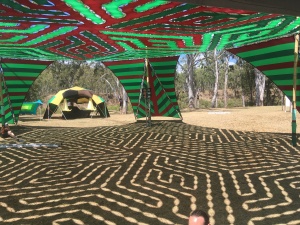 These images are so joyful I can’t help adding more…
These images are so joyful I can’t help adding more… This allows me to see that the design is a portion of Honeycomb (10,10) that I originally designed and blogged for Double Tenth Day, 國慶日/雙十節 , National Day of Taiwan, celebrated by Honeycomb (10,10)
This allows me to see that the design is a portion of Honeycomb (10,10) that I originally designed and blogged for Double Tenth Day, 國慶日/雙十節 , National Day of Taiwan, celebrated by Honeycomb (10,10)




























